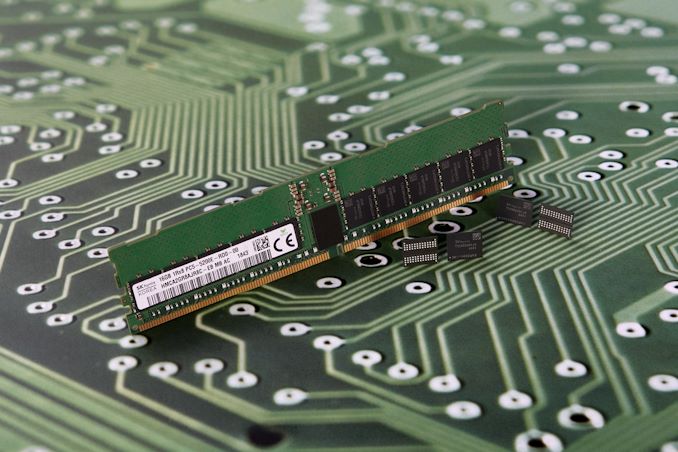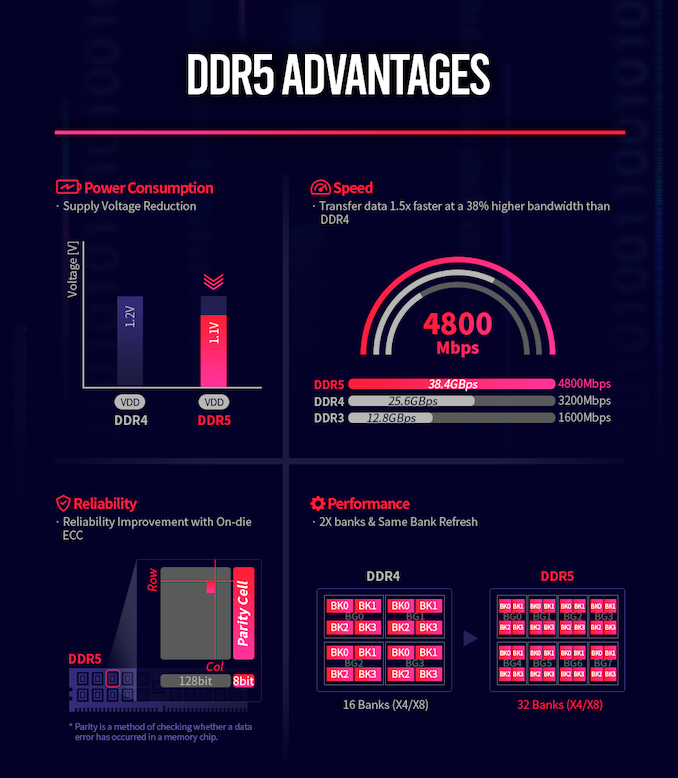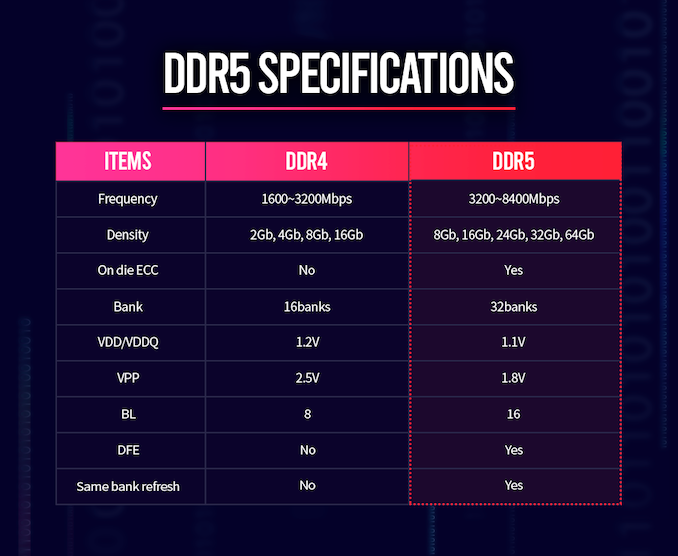SK Hynix: We're Planning for DDR5-8400 at 1.1 Volts
by Gavin Bonshor on April 3, 2020 1:15 PM EST
Back in November last year, we reported that SK Hynix had developed and deployed its first DDR5 DRAM. Fast forward to the present, and we also know SK Hynix has recently been working on its DDR5-6400 DRAM, but today the company has showcased that it has plans to offer up to DDR5-8400, with on-die ECC, and an operating voltage of just 1.1 Volts.
WIth CPU core counts rising with the fierce battle ongoing between Intel and AMD in the desktop, professional, and now mobile markets, the demand to increase throughput performance is high on the agenda. Memory bandwidth by comparison has not been increasing as much, and at some level the beast needs to be fed. Announcing more technical details on its official website, SK Hynix has been working diligently on perfecting its DDR5 chips with capacity for up to 64 Gb per chip.
SK Hynix had previously been working on its DDR5-6400 DRAM, which has 16 Gb which is formed of 32 banks, with 8 bank groups, with double the available bandwidth and access potential when compared with DDR4-3200 memory. For reference, DDR4 uses 16 banks with 4 bank groups. The key solution to improve access throughout is the burst length, which has been doubled to 16 when compared with 8 on DDR4. Another element to consider is DDR4 can't by proxy run operations while it's refreshing. DDR5 is using SBRF (same bank refresh function) which allows the system the ability to use other banks while one is refreshing, which in theory improves memory access availability.
As we've already mentioned, SK Hynix already has DDR5-6400 in its sights which are built upon its second-generation 10nm class fabrication node. SK Hynix has now listed that it plans to develop up to DDR5-8400. Similar in methodology to its DDR5-6400 DRAM, DDR5-8400 requires much more forethought and application. What's interesting about SK Hynix's DDR5-8400 is the jump in memory banks, with DDR5-8400 using 32 banks, with 8 bank groups.
Not just content at increasing overall memory bandwidth and access performance over DDR4, the new DDR5 will run with an operating voltage of 1.1 V. This marks a 9% reduction versus DDR4's operating voltage which is designed to make DDR5 more power-efficient, with SK Hynix reporting that it aims to reduce power consumption per bandwidth by over 20% over DDR4.
To improve performance and increase reliability in server scenarios, DDR5-8400 will use on-die ECC (Error Correction) and ECS (Error Check and Scrub) which is a milestone in the production of DDR5. This is expected to reduce overall costs, with ECS recording any defects present and sends the error count to the host. This is designed to improve transparency with the aim of providing enhanced reliability and serviceability within a server system. Also integrated into the design of the DDR5-8400 DRAM is Decision Feedback Equalization (DFE), which is designed to eliminate reflective noise when running at high speeds. SK Hynix notes that this increases the speed per pin by a large amount.
In the above image from specification comparison between DDR4 and DDR5 from SK Hynix, one interesting thing to note is that it mentions DRAM chips with density up to 64 gigabit. We already know that the chip size of DDR5 is 65.22mm², with a data rate of 6.4 Gbps per pin, and uses its 1y-nm 4-metal DRAM manufacturing process. It is worth pointing out that the DDR5-5200 RDIMM we reported on back in November 18, uses 16 Gb DRAM chips, with further scope to 32 Gb reported. SK Hynix aims to double this to 64 Gb chips which do double the density, at lower power with 1.1 volts.
Head of DRAM Product Planning at SK Hynix, Sungsoo Ryu stated that:
"In the 4th Industrial Revolution, which is represented by 5G, autonomous vehicle, AI, augmented reality (AR), virtual reality (VR), big data, and other applications, DDR5 DRAM can be utilized for next-gen high-performance computing and AI-based data analysis".
SK Hynix if still on schedule with the current Coronavirus COVID-19 pandemic, looks set to enter mass production of DDR5 later this year.
Related Reading
Source: SK Hynix












84 Comments
View All Comments
s.yu - Friday, April 3, 2020 - link
And "DDR4-8400", "This is expected to reduce overall cost reduction"...this is one of the more messier write ups here.Slash3 - Friday, April 3, 2020 - link
Looks like they were fixed. Good to see.valinor89 - Sunday, April 5, 2020 - link
Give them a break, after all we have been saying DDR4-XXXX for 6 years now, that muscle memory will not go away that fast. ;)romrunning - Friday, April 3, 2020 - link
Those tech specs look really nice! It would be really neat if Zen 3 for the desktop surprises everyone by support DDR4 & DDR5 at launch, although that would be a longshot.Probably Zen4 will be the first platform to support DDR5, as it's likely going to have a lot of new things with it (i.e. new CPU socket, maybe PCIe 5.0, etc.).
eek2121 - Friday, April 3, 2020 - link
Zen 3 will almost certainly be DDR4 only. Whether or not Zen 4 supports DDR5 depends on market availability and cost. We could see a situation where Zen 4 is released on both AM4 and AM5, supporting DDR4 and DDR5, respectively.Irata - Friday, April 3, 2020 - link
Would certainly be a possibility - use the same cores but a different io die.FreihEitner - Friday, April 3, 2020 - link
I feel like next year AMD could do something like they did in 2019 with the 7's -- the Ryzen 5000 series, with PCIe 5.0 and DDR5. Release it on May 5th and make a party of it!senttoschool - Friday, April 3, 2020 - link
Don't forget 5nm.Valantar - Saturday, April 4, 2020 - link
Should have timed that for their 50th anniversary though. Such a lack of foresight! :PValantar - Saturday, April 4, 2020 - link
It would be quite a departure for AMD if the follow-up to AM4 didn't support DDR5 - after all, platform longevity is an explicit goal of theirs, at least currently. Of course Zen 3 is supposed to launch on AM4, not "AM5"(?), so Zen 3 will in all likelihood be DDR4-only. There's no way of retrofitting AM4 with DDR5 support, nor would AMD launch a single-generation platform - that would be too expensive (and just plain stupid, pissing off customers by giving them no upgrade path).Still, this is extremely promising for future APUs. A 2021/2022 Zen3/Zen4 "AM5" APU with DDR5-8400 and RDNA 2 would be _amazing_. That is nearly quadruple the memory bandwidth from laptop-standard DDR4-2133, or nearly 3x desktop-"standard" 3200. And if there's one thing limiting APU iGPUs, it's memory bandwidth. Bring on DDR5!